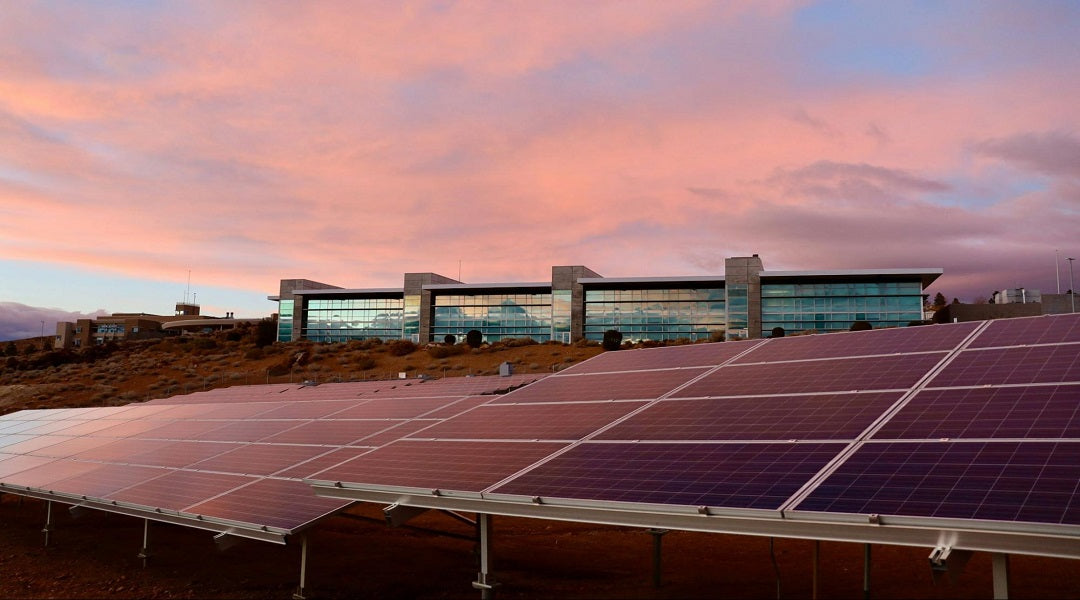A solar tracker is a device that adjusts the position of solar panels to follow the sun's movement across the sky. This allows them to capture more sunlight and generate more electricity for your home.
With a solar tracker, your solar power system can work more efficiently without needing extra panels or space. In other words, you get better results and bigger savings with the same number of panels.
In this article, we’ll explain solar tracking technology in more detail, exploring different types of solar trackers and their advantages. Let’s see if investing in these devices pays off in the long run.
What Is a Solar Tracker?
A solar tracker does for a panel what a sunflower’s stem does for its flower head—it turns it toward the sun, ensuring it captures as much sunlight as possible. This way, your system can produce more renewable energy for your home. Additionally, if you have a solar battery, you can store more power for nighttime, cloudy days, and outages.
Most solar tracking systems are designed for ground-mounted panels, although rooftop-mounted trackers have recently entered the market as well. Therefore, wherever you choose to install solar panels, you can have a tracker set up there to boost their performance.
Solar tracking equipment is usually attached to the panel racking, allowing the panels to move with the sun throughout the day. This movement helps reduce the angle of incidence—the angle between the sun’s rays and the panel’s surface—so that more sunlight is absorbed instead of reflected.
How Do Solar Trackers Work?
Solar trackers work by moving (either automatically or through manual adjustment) to help solar panels follow the sun. There are three main types—active, passive, and manual trackers, each working differently to adjust solar panel positioning.
Active trackers include components such as PV cells, sensors, a PLC (programmable logic controller), signal processors, motion control modules, and a power supply.
When sunlight hits the panel, the system detects its intensity and sends the information to the sensors. The sensors then pass this data to the PLC, which processes it and signals the motor to move the panel.
Passive solar trackers use heat-sensitive fluids that expand and shift in response to sunlight. This process causes the panels to tilt at a narrower angle naturally, without the need for motors or sensors. While not as precise as their active counterparts, these trackers require less maintenance.
Lastly, as the name suggests, manual solar trackers require physical adjustment at various times of the day or season. They’re the simplest and least costly of the three, but they’re not as practical, as someone always needs to monitor the sun and reposition the panels.
Types of Solar Trackers: Dual vs. Single-Axis
There are two main types of solar trackers based on movement and flexibility—single-axis and dual-axis trackers.
Single-axis solar trackers adjust the panels by rotating around one axis of movement. They’re typically aligned with north and south, allowing the panels to arc from east to west to follow the sun from the moment it rises until it sets.
Although they have a high installation cost, single-axis trackers boost solar panel performance enough to compensate for these expenses over time. They work best on flat land in warm, dry climates.
|
Pros |
Cons |
|
Lower cost compared to dual-axis trackers |
Less efficient than dual-axis trackers |
|
More reliable with fewer moving parts |
Less technologically advanced |
|
Longer lifespan |
Risk of instability in strong winds |
Dual-axis trackers are aligned vertically and horizontally, thus moving the panels in two directions—side to side (east-west) and up and down (north-south). This means they can follow the sun’s path from sunrise to sunset while also adjusting to seasonal changes in the sun’s height.
These systems are more expensive and complex, which makes them less common than their single-axis counterparts, even for large-scale solar farms. Still, they can be a great choice for commercial properties with limited roof space. Dual-axis trackers can generate up to 45% more power than fixed panels, depending on location and weather conditions.
|
Pros |
Cons |
|
More efficient in capturing sunlight |
Less reliable due to more moving parts |
|
More precise tracking for better solar panel optimization |
Shorter lifespan compared to single-axis trackers |
|
Better performance in winter |
Higher cost |
4 Key Advantages of Solar Trackers

Some of the key advantages of solar trackers are better solar energy output and maximized panel efficiency.
Let’s take a closer look at each of them:
#1. Increased Energy Output
Unlike fixed solar arrays, which generate peak power only at midday, trackers optimize exposure from sunrise to sunset. Needless to say, this means your system can produce more energy with the same number of panels.
By adjusting the angle of the panels to stay aligned with the sun, trackers can boost solar power production by up to 45%, depending on the location and the system used. This makes them especially beneficial for areas with high electricity demand or limited space for additional installations.
#2. Maximized Panel Efficiency
Fixed panels often experience energy efficiency drops in the morning and late afternoon due to suboptimal angles. Meanwhile, trackers narrow the solar incidence angle, thereby minimizing reflection and maximizing absorption of sunlight. This way, they reduce the impact of cloud cover and seasonal sun shifts.
In addition, solar trackers prevent overheating through better air circulation, keeping photovoltaic cells at an ideal operating temperature. As a result, the panels sustain steady efficiency regardless of the time of day and season.
#3. Prolonged Panel Lifespan
Fixed panels sit at one angle all day, causing uneven exposure and faster degradation in some spots. In contrast, solar trackers help spread sunlight evenly across the panels, ensuring all their parts work more uniformly, which reduces heat stress and slows down wear and tear.
Moreover, some solar panel tracking systems even adjust during harsh weather, like strong winds and hailstorms, to avoid damage. With less strain on the arrays, there are fewer repairs, lower maintenance costs, and longer solar panel lifespans. This makes solar energy a smart investment choice in the long run.
#4. Land Optimization
Since solar trackers help generate more energy per panel, the whole setup doesn’t take up much space. In other words, by increasing energy density, these devices enable smaller installations to meet the same power demands as larger fixed solar systems.
For example, they maximize output per acre in large-scale solar farms, making the best use of available land. Some advanced trackers even adjust tilt angles to minimize shading between rows, allowing for tighter panel placement without losing efficiency.
Is Getting a Solar Tracker Worth It?

Getting a solar tracker can be worth the additional investment in some cases, like installations with limited space and large-scale solar farms. However, not all setups call for a solar tracking system.
The truth is that since the price of solar panels keeps dropping, it’s usually less expensive to install more solar panels than to get a solar tracker. For example, if you install 15 ground-mounted panels with a power rating of 300 watts, you’ll pay between $12,000 and $14,000 on average for the whole system.
That said, let’s say you want to include a single-axis tracker (which is more common than its dual-axis counterpart) in your system. That’s an extra $500 per panel, which adds up to $7,500 in total. For a dual-axis tracker, the price is even higher—around $15,000.
While it’s true that a solar tracker can help your system produce more electricity, the additional savings may not always be worth the upfront cost of the equipment.
Let’s sum the data in a table:
|
Solar system type |
System cost |
Annual energy savings |
Estimated payback period |
|
Fixed ground-mounted system |
Between $12,000 and $14,000 |
$1,100 |
13 years |
|
Ground-mounted system with a single-axis tracker |
Between $19,500 and $21,500 |
$1,430 |
15.5 years |
|
Ground-mounted system with a dual-axis tracker |
Between $27,000 and $29,000 |
$1,540 |
19 years |
Solar Tracker Maintenance
Solar trackers need regular maintenance, even more so than fixed panels, since their moving parts are more prone to wear and tear. This includes lubricating motors and gears, tightening bolts, and checking for damage and rust.
Additionally, dust and debris can pile up on the sensors, so it’s necessary to clean them periodically to maintain efficiency. Lastly, active trackers have electrical components, which require routine inspections, preferably by a professional.
Switch to Solar Power With the Best Equipment
Switching to solar power is a wise decision for many reasons—you can reduce your carbon footprint, save on electrical bills, and even achieve energy independence. That is if you choose quality equipment and installation services.
At Portable Sun, we offer both. You can choose components for your system from our extensive collection of panels, batteries, solar inverters, solar generators, and more. The best part is that they can all be at your doorstep thanks to our installer program. You can go solar with just a few simple clicks and start saving in no time!
Final Thoughts
You can tell what a solar tracker is by its name—it’s a device that moves panels to track the sun across the sky. This way, they soak up more sunlight throughout the day and year, which means your home gets more clean, renewable energy.
However, solar trackers don’t always pay off. While they’re a good solution for smaller setups and areas with higher electricity demands, they may not be as cost-effective for larger systems or regions with less sunlight. In these cases, fixed solar panels offer a better return on investment.
What Is a Solar Tracker FAQ
#1. What are the cons of solar trackers?
Some of the cons of solar trackers include high installation costs, proneness to wear and tear due to movable parts, and high maintenance requirements. Additionally, they’re less effective for large setups and in areas with less sunlight.
#2. How much more efficient are solar trackers compared to fixed solar systems?
Solar trackers are up to 45% more efficient compared to fixed solar setups—they can increase energy production by that much. Specifically, this goes for dual-axis trackers, which are more precise but less commonly used than single-axis trackers.
#3. Are solar trackers suitable for all types of solar installations?
No, solar trackers aren’t suitable for all types of solar installations. They’re best for smaller systems and areas with high energy demands and consistent sunlight. In other cases, fixed solar panels are a better solution.
#4. What’s the price of solar trackers?
The price of solar trackers depends on their type, the location, and the installer. Single-axis solar trackers cost $500 on average per panel, while dual-axis trackers are more expensive—they cost around $15,000 for the whole system.
#5. How long do solar trackers last?
Solar trackers typically last between 20 and 25 years with proper maintenance. While their lifespan is similar to that of solar panels, they require more frequent upkeep due to their moving components.
Disclaimer: The content on Portable Sun is for informational purposes only. Electrical work can be dangerous—always consult a qualified professional. We are not liable for any injuries, damages, or losses from installation or use. Always follow local regulations and safety guidelines when handling electrical components.

